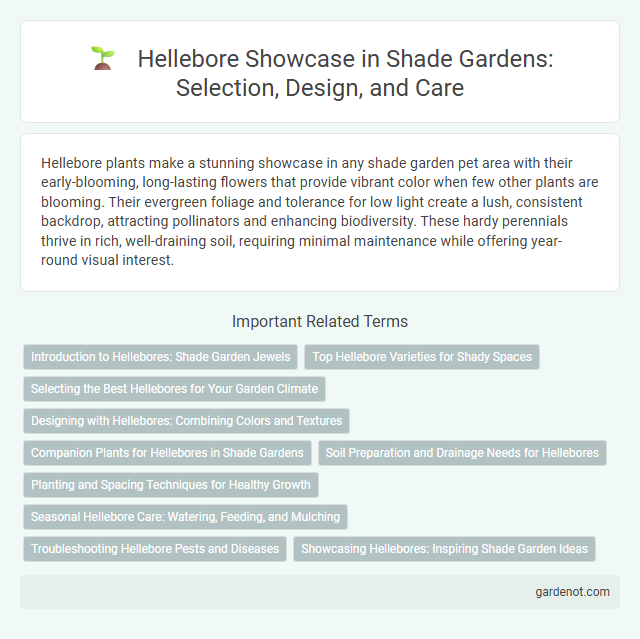Hellebore plants make a stunning showcase in any shade garden pet area with their early-blooming, long-lasting flowers that provide vibrant color when few other plants are blooming. Their evergreen foliage and tolerance for low light create a lush, consistent backdrop, attracting pollinators and enhancing biodiversity. These hardy perennials thrive in rich, well-draining soil, requiring minimal maintenance while offering year-round visual interest.
Introduction to Hellebores: Shade Garden Jewels
Hellebores, often called shade garden jewels, thrive in low-light conditions and bring early spring color to shaded areas. Known for their leathery, evergreen foliage and nodding, cup-shaped flowers, these perennials offer a diverse palette from whites and pinks to deep purples and greens. Their drought tolerance and deer resistance make them ideal for sustainable and low-maintenance shade gardens.
Top Hellebore Varieties for Shady Spaces
Hellebores, known for their early bloom and shade tolerance, thrive in shaded garden areas, making them a perfect choice for dimly lit spaces. Top varieties such as Helleborus orientalis, with its vibrant pink and purple flowers, and Helleborus foetidus, noted for its unique greenish blooms, provide both color and texture under tree canopies or shaded borders. These resilient perennials offer long-lasting blooms from late winter to spring, enhancing the ambiance of shade gardens with minimal maintenance.
Selecting the Best Hellebores for Your Garden Climate
Hellebores thrive in shaded garden areas with well-drained soil and consistent moisture, making them ideal for temperate climates with mild winters. Select varieties such as Helleborus niger for colder regions due to its frost tolerance, or Helleborus orientalis for zones with milder winters, ensuring vibrant blooms from late winter to early spring. Matching hellebore species to your garden's USDA hardiness zone optimizes growth and maximizes floral display throughout the season.
Designing with Hellebores: Combining Colors and Textures
Designing with hellebores in shade gardens enhances visual interest by combining their diverse colors and textures, such as deep purples, soft pinks, and creamy whites with serrated, leathery foliage. Pairing hellebores with ferns and hostas amplifies contrast, creating layered depth and seasonal appeal. Selecting varieties like Helleborus orientalis alongside hellebores niger offers extended bloom times and complementary textures.
Companion Plants for Hellebores in Shade Gardens
Hellebores thrive in shade gardens, pairing well with companion plants like ferns, hostas, and astilbes that enhance their early spring blooms and provide contrasting foliage textures. These shade-loving perennials create a layered effect by offering varied heights and colors, enriching the garden's visual appeal throughout the growing season. Incorporating evergreen groundcovers such as pachysandra or ivy ensures consistent greenery, complementing the hellebore's delicate flowers and maintaining garden interest in low light conditions.
Soil Preparation and Drainage Needs for Hellebores
Hellebores thrive in well-drained, humus-rich soil that retains moisture without becoming waterlogged, making soil preparation essential for optimal growth. Incorporate organic matter such as compost or leaf mold to improve soil structure and enhance drainage while maintaining adequate moisture levels. Ensure planting sites have a slight slope or raised beds to prevent standing water, which can cause root rot and other drainage-related issues for hellebores.
Planting and Spacing Techniques for Healthy Growth
Hellebores thrive in shaded garden areas with well-drained soil enriched with organic matter, requiring planting depths that keep the crown just below the soil surface. Space plants 18 to 24 inches apart to ensure adequate air circulation, reducing the risk of fungal diseases and promoting robust root development. Consistent moisture without waterlogging supports healthy growth, while mulching helps retain soil moisture and regulate temperature.
Seasonal Hellebore Care: Watering, Feeding, and Mulching
Seasonal care for hellebores in shade gardens includes consistent watering to keep the soil moist but well-drained, preventing root rot and promoting healthy growth. Regular feeding with a balanced, slow-release fertilizer during early spring enhances flowering and foliage vigor. Mulching with organic materials like leaf mold or compost maintains soil moisture, regulates temperature, and suppresses weeds essential for optimal hellebore development.
Troubleshooting Hellebore Pests and Diseases
Hellebores often face issues from pests such as aphids, vine weevils, and slugs, which can cause leaf damage and stunted growth. Fungal diseases like black spot and downy mildew frequently affect Hellebores, leading to yellowing leaves and deformed flowers. Regular inspection and timely application of insecticidal soap or fungicides help maintain healthy Hellebore plants in the shade garden.
Showcasing Hellebores: Inspiring Shade Garden Ideas
Hellebores thrive in shade gardens, offering vibrant early spring blooms that brighten dim woodland areas. Their evergreen foliage and diverse flower colors--from creamy white to deep purple--create an alluring, low-maintenance display that complements other shade plants like ferns and hostas. Incorporating Hellebores into shade garden designs provides year-round interest and natural elegance, inspiring gardeners to create serene, textured landscapes.
Hellebore showcase Infographic

 gardenot.com
gardenot.com